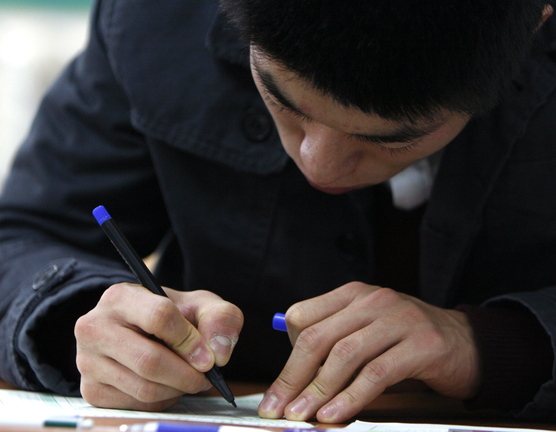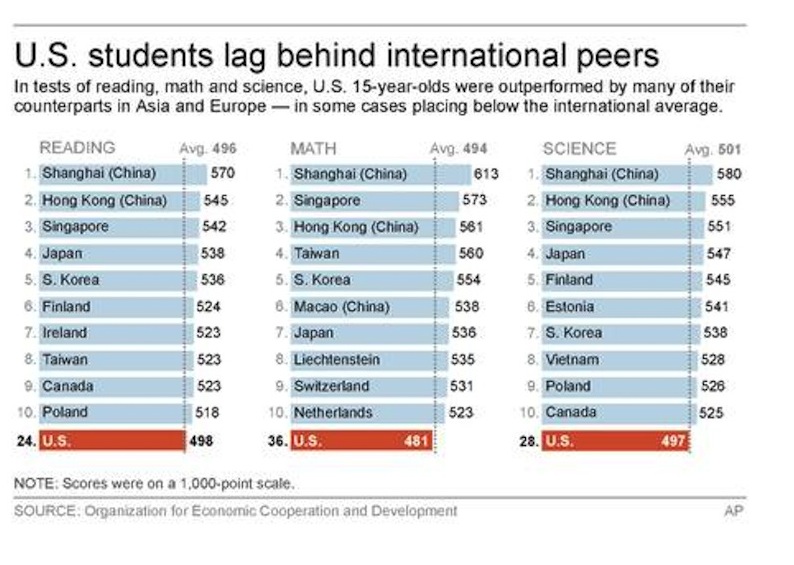Scores in math, reading and science posted by 15-year-olds in the United States were flat while their counterparts elsewhere – particularly in Shanghai, Singapore and other Asian provinces or countries – soared ahead, according to results of a well-regarded international exam released Tuesday.
While U.S. teenagers scored slightly above average in reading, their scores were average in science and below average in math, compared to 64 other countries and economies that participated in the 2012 Program for International Student Assessment, or PISA, which was administered last fall. That pattern has not changed much since PISA was first administered in 2000.
“Our scores are stagnant. We’re not seeing any improvement for our 15-year-olds,” said Jack Buckley, commissioner at the National Center for Education Statistics, the research arm of the U.S. Department of Education. “But our ranking is slipping because a lot of these other countries are improving.”
The test scores offer fresh evidence for those who argue that the United States is losing ground to competitors in the global market and others who say a decade’s worth of school reform has done little to improve educational outcomes.
“While the intentions may have been good, a decade of top-down, test-based schooling created by No Child Left Behind and Race to the Top – focused on hyper-testing students, sanctioning teachers and closing schools – has failed to improve the quality of American public education,” Randi Weingarten, president of the American Federation of Teachers, said in a statement. The AFT released a video on Monday in which it implored the public not to blame teachers, the unions, parents or students for poor PISA results.
Shanghai dominated the exam, occupying the top slot in all three subjects. The Chinese province has catapulted to the top in PISA over the past decade after focusing on teacher preparation and investing in its most challenging classrooms, among other things.
Germany, Poland and Vietnam were among several countries that made significant improvements in their test scores while Finland, which had been a top-scorer in the past several exams, dropped from its elite perch.
“Finland is still a strong performing educational system that’s seen a drop,” Andreas Schleicher, deputy director for education and skills at the Organization for Economic Cooperation and Development, said during a briefing with reporters Monday. “I’m not yet able to explain it.”
The test, administered every three years by the OECD, measures performance on math, reading and science. PISA is designed to test whether students can apply what they’ve learned in school to real-life problems. Approximately 510,000 15-year-olds in public and private schools took the paper-and-pencil exam in 2012.
On the math portion, 28 countries tested better than the United States. In science, 22 countries posted better results than the United States. In reading, 19 countries had higher scores than U.S. students.
Three states – Massachusetts, Connecticut and Florida – participated in the test and were ranked as if they were individual countries to see how their students compared internationally.
Students in Massachusetts and Connecticut scored above both the national and PISA average in math, while Florida scored below those averages. The same pattern repeated in science testing. In reading, Massachusetts and Connecticut scored above the U.S. and PISA averages while Florida teenagers scored about the same as the U.S. and PISA average.
Not only did the United States score below average compared to the other countries that took the PISA math exam, it had fewer top performers. Some observers say the United States does not perform well in international competitions because it is a large, diverse country, with the highest child poverty rate among industrialized countries.
But countries like Vietnam, where 79 percent of students are economically disadvantaged, outscored U.S. students in math.
“So it’s not demography itself. Those demographics are a factor, not the only factor,” Buckley said.
A weak curriculum could be the culprit, the report suggested.
Send questions/comments to the editors.




Success. Please wait for the page to reload. If the page does not reload within 5 seconds, please refresh the page.
Enter your email and password to access comments.
Hi, to comment on stories you must . This profile is in addition to your subscription and website login.
Already have a commenting profile? .
Invalid username/password.
Please check your email to confirm and complete your registration.
Only subscribers are eligible to post comments. Please subscribe or login first for digital access. Here’s why.
Use the form below to reset your password. When you've submitted your account email, we will send an email with a reset code.